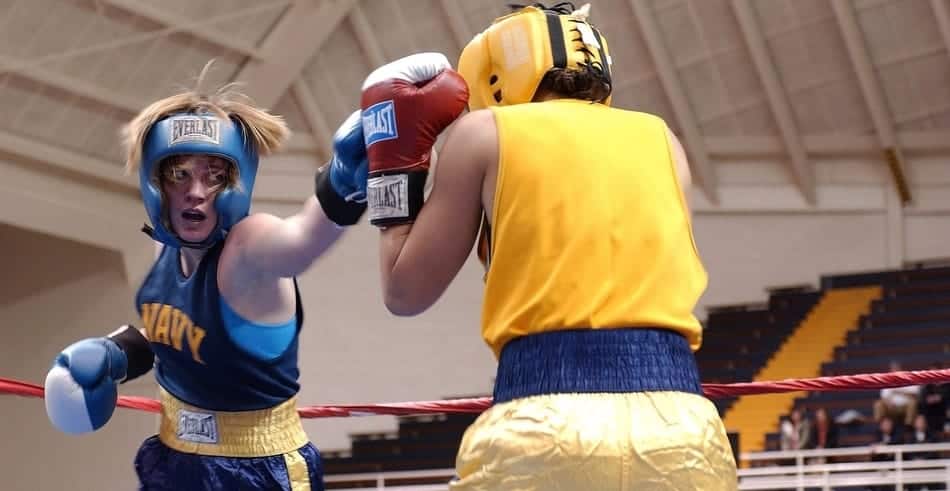
The jab is the first punch you learn when you start boxing. It’s not the most powerful punch but it’s really helpful for controlling the distance. You can use it also to set up heavier punches.
So it’s really cool if you have a quick and precise jab. You can just jab your opponent from a distance, without putting your self at risk. But what to do when your opponent is the one with the better jab?
How to block those jabs effectively? The easiest way to block a jab is to just catch it with your rear hand (or lead hand if fighting with someone in the opposite stance) and the to knock it away.
But there are several things you need to know so you can execute the technique properly. Let’s dive into them:
Stance
If you are a beginner, the first question that you will hear from your coach when you go to the gym will be: “Which is your dominant hand?” If you say that you are right-handed, he will tell you that you need to stay in the orthodox stance. Which means to place your left foot in front of your right foot.
If you are left-handed, you need to use the southpaw stance, which is the opposite of the orthodox one.
Here is what you need to do to have a proper boxing stance:
- Step with your left foot in front of your right foot -A little bit more than the width of the shoulders. If you are a southpaw your right foot needs to be in front
- Make a little step on the right with your back foot – Your feet shouldn’t be positioned on a straight line under your body. Otherwise, you will be unbalanced while throwing rear hand hooks or when you get hit by lead hooks. So you need to make a step to the right with your back foot if you are orthodox. And a little step on the left if you are a southpaw.
- Pivot your foot– The toes of your front foot need to point at almost the same directions as your chest
- Bend your knees a little bit – Thus you will be more balanced
- Try to stay on the balls of your feet – That way you will increase your quickness and mobility
The stance of every boxer is different depending on his style. Some boxers like more sideways stances, while others like to square up. But if you are a beginner, the stance described above is a great start.
Hands
The hand positioning is the second most important aspect of the boxing stance. The idea is to place your hands in such a position that you can easily defend your body and your head but also to be able to fire back.
Let’s go through the steps:
- Make a fist and bring hands up
- Place your backhand on your right cheek – If you are a southpaw, place it on your left cheek
- Place your lead hand in front of your face – Be careful not to block your vision while doing that
- Bring your elbows in – Your elbows will protect your body, so make sure they are placed on it.
*If your stance is correct, your lead shoulder should point in the direction of the opponent.
Chin
One of the worst places to get hit is in the chin. That’s because a punch there makes the head accelerate fast which makes the brain slams into the inside of the skull. That’s why the most of the knockouts in boxing are caused by a clean shot in the chin.
So you need to make sure that your chin is protected. You can protect it by keeping it down and your shoulder (especially the lead shoulder) up. Your chin needs to be lower than the level of your lead shoulder. That way it will be very hard for your opponent to land the jab or any kind of punch there.
Blocking Steps
When you block, your gloves or forearms will decrease the impact of the jab DRAMATICALLY. And now, after you already know all the basic steps, it’s time to see what exactly you need to do to block a jab.
How to block a jab:
- Wait for your opponent to throw the jab – While doing so, don’t stay too close to him, otherwise, you won’t have enough time to react
- Bring your chin down – It’s much better to take the punch on your forehead than on your chin. So keep it down, where is protected by the lead shoulder.
- Catch the jab with your right hand (Or with your left hand if the other boxer is in a southpaw stance) – just meet it with an open hand
- Don’t close your eyes – This is hard to do in the beginning, because of your natural reflexes. But after you gain some experience it won’t be a problem for you. It’s important to keep your eyes open while blocking, because your opponent may decide to follow up the jab with another punch. And you won’t be able to see it and to block it.
- Recover – Right after you block the punch, return to your standard position. Because, if you only stay covered up, and don’t fire back, you may turn into a punching bag.
Tips:
- Don’t try to catch the punch by reaching your hands. Keep them in front of your face and just slightly move your hand forward so you can meet the jab with your glove. Otherwise, you are leaving yourself open for hooks.
- Don’t move backward – Because by doing that you are giving ground. And, eventually, your rival will trap you against the ropes (or against the wall if you spar outside the ring). Also, when your opponent see that he can easily pressure you, that can make him feel more confident. And that’s what you want. Your goal is to make him reactive and guessing. That way you will be the one that is controlling the fight.
Vision
When you bring the big boxing gloves in front of your face while blocking a jab, it’s obvious that you will also block your vision. But that’s not a good idea during a fight or a sparring. You should always keep your eyes on your opponent so you can see his moves or to find openings.
To do that, when I block a jab to the head, I like to place my gloves high, on my forehead, just above my eyes. That way, I am blocking not so with my gloves, but with my forearms. Also, my thumbs are pointing almost right at me. Thus my gloves aren’t blocking my vision so much.
Some people block the jab with their gloves because they are big (especially the gloves for sparring) which really decreases the impact of the punch. But what I noticed is that when I do that, I cover my eyes too much. And that can be really dangerous especially if you spar against a more experienced boxer. Because he will usually use the moment when you don’t see him to land some body shots. Or he can wait for you to lower your hands and then catch you over the top. That’s why is really important to keep your eyes on the opponent.
Jab to the body
The jab to the body is another commonly used technique. Its main purpose usually isn’t to hurt your body so much but to distract your attention or to set up more powerful punches. But still, to be punched in the body, even with only a jab, can be painful. So it’s important to know how to block this variation of the jab too. Here is how you can do that:
- Wait for the other boxer to throw the jab
- Bring your elbow down
- Try to not lower your body
- Meet the jab with your elbow
- Recover your stance
To block the jab to the body you just need to time it and to bring your elbow down. If the punch is coming from your left, use your left elbow to block it and vice versa.
As I mentioned above, you shouldn’t lower your body. That’s a common beginner mistake and is dangerous because your opponent may catch you with an uppercut.
Tip: Don’t drop your hands when blocking, that is what your rival wants you to do. The jab to the body is usually just a set up for bigger punches to the head. Don’t take the bait. Just use your elbows to block it.
Different stances
Now we know how to block a jab when fighting against someone who is in the same stance as us. But what if we are in opposite stances. Is there any difference?
Actually, there is a difference…
If you and your opponent are in opposite stances, for example, you are using the orthodox stance and he is a southpaw, your lead hand will face his lead hand. And that is important because the jabs will come from the opposite direction compared to when fighting against another orthodox boxer.
Usually, when two orthodox boxers are fighting they block the jabs using their right hand. That’s because their rival throws the jab using his left hand, so it will come from their right side. And when they fight against southpaws, they are blocking the jab with their left hand.
Yes, this is not a big deal, but it can be a little bit confusing if you are a beginner and you are used to blocking the jab with your rear hand.
The other difference is that because of the positioning of your opponent’s lead hand, you can trap his glove and stop the jab before it’s even thrown. Which leads us to the next part of the article.
Other ways to defend the jab
The blocking is the first defensive move you learn. But there are many other ways to defend the jab. Some of them are really advanced techniques, but others are very easy and basic and you can try them in your next sparring session.
Parry the jab
1. Parry with your power hand
This is the most commonly used way to parry a jab. Here is how you to do it:
- Place your rear hand just in front of your cheek
- Keep the hand open – It’s much easier to catch the punch with an open hand than with a fist
- Wait for the other fighter to throw a jab at you
- Catch the jab with your rear hand and push it away – If you are in an orthodox stance, push it down or to your left. And push it to your right if you are a southpaw
- Recover – Place your rear hand in the starting position
You shouldn’t move your hand more than 3-4 inches. And again, try to meet the jab, not to reach your hand while trying to catch it. Otherwise, you leave yourself exposed for hooks.
Tips:
- You can counter your opponent by throwing a jab to the head immediately after you parry his jab. This is one of the first counter techniques that you learn.
- I recommend parrying the jab with your power hand especially when fighting against someone who is in the same stance as you. Because in this case, the jab will come from your right (and from your left if you are a southpaw). So it’s much easier to catch the punch with your power hand.
2. Parry with your lead hand
This variety of parrying is almost the same as the one I described above. The only difference is in the hand you are using to parry.
Also, in the example above I mentioned that you can push your opponent’s hand to your left or right after you catch the jab. In this case (when you parry with your lead hand), I recommend to push it only down. That way you can counter your rival with your power hand over the top, where he will be defenseless.
This type of parrying is really effective when you are fighting against someone in the opposite stance. Because you have plenty of opportunities to counter.
The easiest counter is to throw a cross right after you parry the jab. But you can also throw your own jab or a lead hook. It will be very hard for your opponent to defend himself from the counters, simply because there are so many possibilities.
Slip the jab
To slip basically means to move your head to slightly to your left or right to avoid the punch (in our case – the jab). You also need to bend your knees a little bit and to rotate your shoulder to the same direction where you moving your head. I recommend keeping your left hand up if you slip to your right, and vice versa, just in case.
It’s a really cool technique, because, using it, you can land very powerful counters (especially hooks and overhands). Which explains why many knockout punches are landed after a “slip and counter”.
This is a more advanced defensive technique because if you don’t time the jab correctly or slip to the wrong direction you can end up with a broken nose (or even worse). So I recommend practicing slipping a lot with your coach or training partner before you try it in a sparring.
Tip: When slipping, don’t move your head too much. Around 6-7 inches (a little bit more than the width of the glove) are enough, to move your head off the danger zone.
There are two variations of slipping, depending on the way you slip the jab:
1. Slip outside the jab
To slip the jab to the outside the jab means to move your head to the direction of your power hand when your opponent is in the same stance as you. And to the direction of your lead hand when you are fighting against someone in the opposite stance.
Pros
When slipping outside the jab, the other boxer can’t catch you with the cross. You can also land some power hand body or head counter punches (or lead hand punches when fighting against someone in the opposite stance).
Cons
You are vulnerable for power hand uppercuts or overhands.
2. Slip inside the jab
To slip the jab to the inside you need to move your head to the direction of your lead hand. And to the direction of your power hand when sparring/fighting against an opponent in the opposite stance.
Pros
You can load a big power hand punches
Cons
You are really vulnerable to straight punches or rear hand hooks



